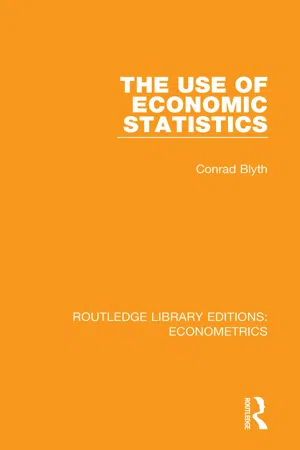Economics
Real Income
Real income refers to the amount of goods and services that can be purchased with a person's income after adjusting for inflation. It is a measure of the purchasing power of an individual's income. Real income is important in understanding the standard of living of individuals and households.
Written by Perlego with AI-assistance
Related key terms
3 Key excerpts on "Real Income"
- eBook - ePub
- Conrad Blyth(Author)
- 2018(Publication Date)
- Routledge(Publisher)
CHAPTER FOURChanges in Incomes1. Income, Output And Expenditure
Income has at least three meanings. It can refer to the satisfactions obtained from consuming, or enjoying the use of, material goods and services—this is psychic income and can not be measured directly. Secondly, income means the goods and services themselves which we consume or use. This is called Real Income, and is measureable. Finally, as most of us work for a money wage or salary which we use to buy the goods and services we want, we are familiar with the idea of money income —the payments made to us for the services we render to others, and the payments we receive in the form of grants such as pensions and allowances. Real Income and money income are the ideas which interest the economist.The economist aims at understanding the workings of the economic system and its effects upon people's lives. This system, whether it is organized on collective or individualistic lines, embraces thousands of industries, millions of types of goods and services and a variety of methods of organization. To understand it inevitably means to simplify it to get a bird's eye view of its main features. After we have understood the main features we can then fill in the details as is necessary. It is the purpose of the estimates of national income, expenditure and output to give a bird's eye view of some of the more important features of the economy—the size, composition, origin and use of the income produced in the economy.The national income is the flow of goods and services produced in the economy in a given period of time, expressed in money terms, after allowance has been made for the value of goods and services used up in the process of production. Note first that a number of arbitrary or conventional decisions have to be made about the extent of the economy (the geographical area covered: in this chapter we are concerned with political unit known as the United Kingdom), and the period of time during which we measure the value of the goods and services produced (for statistical reasons this is one year or one quarter). The word flow is used in the definition to distinguish the idea of national income from the related idea of capital and natural resources which is a stock of wealth. In economics we usually speak of the stock of capital and natural resources (including the abilities of the human population) producing a flow of Real Income. Note also that we deduct the value of the goods and services used up in the process of production. If a tanner, for example, produced £100 worth of leather and sold it to a bootmaker who out of it made boots which he sold for £300, it would be wrong to calculate the national income as £100+£300=£400, for the £300 worth of boots produced includes the £100 worth of leather—the activities of the tanner and bootmaker combined contribute £300, not £400, to the national income. An alternative way of deriving the correct figure is to say that the net output of the bootmaker is £300—£100=£200 (the value of the boots less - No longer available |Learn more
Macroeconomics
Theories and Policies
- Dr Rajesh Gade, Dr Avinash Hande, Dr Vikas Barbate, Prof. Vinodkumar Pathade(Authors)
- 2023(Publication Date)
- Blue Rose Publishers(Publisher)
National Income 2.1. Meaning:National income refers to the values of the goods and services provided by the country during the financial year. It is the net result of all the economic activities of a particular country during a period of time-usually one year. National income is valued in monetary terms. The measurement of national income is significant as it helps us to understand the overall size of the economy and the level of country's economic performance. Calculating national income makes it easy to compare the standard of living of people from different nations. With the help of the statistics related to national income, a particular country can trace the trend or speed of economic growth in relation to previous years. Therefore, it can be said that national income is one of the most crucial concepts in macroeconomic analysis. To gain a better understanding about national income, let us study some definitions in the next section.National income is an aggregate value of total income earned by all individuals, businesses, and organizations within a country's borders during a specific period. It consists total income generated from various sources, such as wages and salaries, profits, rental income, interest, and dividends.The national income reflects the economic health of a country. It helps to policymakers in decision-making process regarding taxation, government spending, and other economic policies. National income is measured through the gross domestic product (GDP). It is a total value of all goods and services produced within a country's borders during a specific period.National Income would be measured through Gross National Income (GNI), Net National Income (NNI) and per capita income. GNI is the aggregate total of Income generated by a country's residents and it’s also including income generated from abroad. NNI is the calculating by deducting depreciation of capital assets from GNI. Per capita income is the average total of Income of each, and every person of a country and it’s calculated by dividing the total national income by total population of the Nation. - eBook - ePub
Work and Wealth (Routledge Revivals)
A Human Valuation
- J. A. Hobson(Author)
- 2010(Publication Date)
- Routledge(Publisher)
Reports of the First Census of Production for the United Kingdom (1907) as the basis for the round figures adopted here for aggregate income and for savings. As a matter of fact Mr. Flux assigns to savings a slightly higher figure and proportion of income than that taken here. But since for our purpose nothing depends upon the exactitude of the figures (and indeed Mr. Flux claims no such exactitude for his) it is more convenient for us to take the round figures of our text, though probably in both instances, i. e. aggregate income and savings, they are somewhat below the true figures for 1912.of any sort of income, whether as wages, rent, salary, interest, profit, fees or otherwise, involves the coming into being of a bit of ‘real’ income in the shape of some material goods or some saleable service.1 This fact once grasped, however, it becomes evident that the £2,000,000,000, said to be the nation’s income, is merely the monetary representative of goods and services which are the net product of the economic activity of the year, the quantity of wealth produced over and above that which has gone to maintain the existing material fabric of industry. The aggregate amount of ‘wealth produced’ is, of course, considerably greater, for a large quantity of the productive power must continually be employed in repairing the wear and tear sustained by the material instruments of production, the land, buildings, machinery and tools and other forms of ‘fixed’ capital, and in replacing the raw materials and other forms of ‘circulating’ capital which have passed out of the productive processes into consumable goods. The net ‘real’ income consists of the goods and services produced over and above this provision for the maintenance of the material structure of the system.There is, however, an important qualification to this mode of reckoning the net Real Income of the nation which needs mention. While the portion of the current product which goes to replace this wear and tear of land and capital is not included in the goods and services represented by the £2,000,000,000 and classed as real net income, the wear and tear or maintenance fund of labour is included in it. When consideration is taken of the distribution of what is often termed the national dividend between the respective owners of the factors of production, this anomaly is seldom borne in mind. In estimating the income of labour the replacement fund is counted; in estimating the income of land and capital it is not counted. But, illogical as this discrimina
Index pages curate the most relevant extracts from our library of academic textbooks. They’ve been created using an in-house natural language model (NLM), each adding context and meaning to key research topics.


